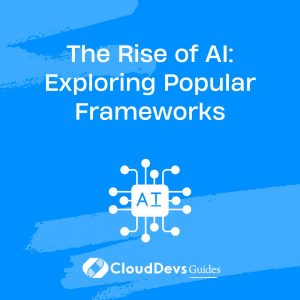The Rise of AI: Exploring Popular Frameworks
Artificial Intelligence (AI) has been revolutionizing industries across the globe, from healthcare to finance, and entertainment to transportation. With the growing demand for AI-powered solutions, developers are continually seeking efficient ways to build, train, and deploy machine learning models. Thanks to advancements in technology, numerous AI frameworks have emerged, offering a plethora of tools and resources to make AI development more accessible and effective.
In this blog, we will delve into the world of AI frameworks, understanding their importance, and exploring some of the most popular ones. From TensorFlow to PyTorch and scikit-learn, each framework plays a significant role in driving the AI revolution.
1. The Significance of AI Frameworks
AI frameworks act as a backbone for developing machine learning models by providing pre-built functionalities, optimized algorithms, and data structures. These frameworks help simplify the development process, allowing developers to focus on model architecture and problem-solving rather than worrying about the nitty-gritty of low-level operations.
With AI frameworks, developers can:
Create and manage complex neural network architectures with ease.
- Take advantage of pre-trained models to bootstrap their projects.
- Utilize optimization techniques for faster and more efficient model training.
- Access tools for data preprocessing and augmentation to enhance data quality.
- Deploy models to various platforms, including mobile devices and cloud services.
- Now, let’s explore some of the most popular AI frameworks and their key features.
2. TensorFlow: Powerhouse of AI
2.1 Introduction to TensorFlow
As one of the most widely used AI frameworks, TensorFlow, developed by Google Brain, has become synonymous with machine learning. Its versatility, scalability, and excellent community support make it a top choice for both beginners and seasoned developers.
2.1.1 Key Features of TensorFlow
TensorFlow boasts several essential features:
- Eager Execution: TensorFlow’s Eager Execution mode allows developers to execute operations dynamically, enabling easier debugging and a more intuitive programming experience.
Code Sample:
python import tensorflow as tf # Enable Eager Execution tf.config.experimental_run_functions_eagerly(True) # Perform a simple addition x = tf.constant([1, 2, 3]) y = tf.constant([4, 5, 6]) result = x + y print(result)
2. TensorFlow Extended (TFX): TFX provides a platform for deploying production machine learning pipelines, enabling seamless integration from research to deployment.
3. TensorFlow Lite: This framework allows developers to deploy machine learning models on mobile and IoT devices, making AI applications more accessible.
2. PyTorch: Flexibility and Intuitive Interface
2.1 Embracing PyTorch
PyTorch, an open-source AI framework, has gained significant traction due to its dynamic computation graph, making it a favorite among researchers and academics. Developed by Facebook’s AI Research lab (FAIR), PyTorch has a flexible and intuitive interface, making it easy for developers to experiment and iterate quickly.
2.2 Key Features of PyTorch
PyTorch is loaded with features that appeal to machine learning enthusiasts:
- Dynamic Computational Graph: PyTorch’s dynamic computational graph allows developers to define models and make changes on-the-fly, providing more flexibility and ease in debugging.
Code Sample:
python import torch # Enable Autograd x = torch.tensor([2.0], requires_grad=True) y = 3 * x + 2 y.backward() print(x.grad) # Output: tensor([3.])
2. TorchScript: PyTorch allows developers to convert their Python code into a more efficient TorchScript representation, optimizing model execution.
3. Rich Ecosystem: With libraries like TorchVision for computer vision tasks and TorchText for natural language processing, PyTorch offers a rich ecosystem for various AI applications.
3. scikit-learn: Your Go-To for Classical ML
3.1 Mastering scikit-learn
While TensorFlow and PyTorch focus on deep learning, scikit-learn is designed for traditional machine learning tasks. It is a versatile and easy-to-use AI framework, built on top of NumPy, SciPy, and Matplotlib.
3.1.1 Key Features of scikit-learn
scikit-learn offers an array of features that cater to classical machine learning:
- Comprehensive Algorithms: The library provides a wide range of algorithms for classification, regression, clustering, dimensionality reduction, and more.
Code Sample:
python
from sklearn.linear_model import LogisticRegression
from sklearn.datasets import load_iris
from sklearn.model_selection import train_test_split
from sklearn.metrics import accuracy_score
# Load the iris dataset
data = load_iris()
X, y = data.data, data.target
# Split the data into training and testing sets
X_train, X_test, y_train, y_test = train_test_split(X, y, test_size=0.2, random_state=42)
# Create a Logistic Regression model
model = LogisticRegression()
# Fit the model on the training data
model.fit(X_train, y_train)
# Make predictions on the test set
predictions = model.predict(X_test)
# Calculate accuracy
accuracy = accuracy_score(y_test, predictions)
print(f"Accuracy: {accuracy}")
2. Data Preprocessing: scikit-learn offers a wide range of tools for data preprocessing, including feature scaling, encoding categorical variables, and handling missing values.
3. Model Selection and Evaluation: The framework provides utilities for evaluating model performance and selecting hyperparameters using techniques like cross-validation.
Conclusion
AI frameworks have played a pivotal role in democratizing AI development, making it accessible to a broader audience. TensorFlow, PyTorch, and scikit-learn are just a few examples of the powerful tools available to developers, each catering to different needs within the AI landscape. Whether you’re building deep learning models with TensorFlow, conducting research with PyTorch, or implementing classical machine learning algorithms with scikit-learn, these frameworks empower you to turn cutting-edge AI concepts into real-world solutions.
So, dive into the exciting world of AI frameworks, explore their vast capabilities, and unleash the potential of artificial intelligence to transform the way we live and work.
Table of Contents









